RetroLisa
------------------ |
1910s Travel
part 1 | |
|
___________________________________________________________________________________________________________
|
|
|
RetroLisa
| _________________________________________________________________ | __ | _______________________________ | _______ | Train & Trolley
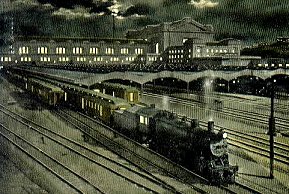
trains
In the 1910s, long-distance travel was accomplished by train.
Chicago was a major rail hub during this decade. Heading east, you could ride the Broadway Limited or the 20th Century Limited to New York City. The California Limited took you from Chicago to Los Angeles. The Illinois Central, which had an extensive network of routes between Chicago and New Orleans, brought many southern blacks to northern cities during the Great Migration.
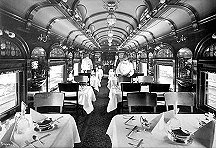
The wealthy elite traveled in private Pullman cars, which featured plush carpets, fine furniture, and exquisite woodwork. For the rest of us, there were dining cars, sleeping cars, lounge cars, and club cars.
Some trains did not have dining car service. During water stops, passengers ate quick meals at depot lunch counters and nearby lunchrooms. On the Atchison, Topeka & Santa Fe line, passengers ate their meals at Fred Harvey restaurants during regularly-scheduled meal stops. The Fred Harvey Company also operated restaurants and provided fully-staffed dining car service to a handful of other railroads. Rail lines with dining car service took pride in offering the finest food available.
African-American porters, bartenders, and waiters provided courteous and efficient service. The porter made up the sleeping berths, controlled the steam heat, sent telegrams, and mailed letters. In the lounge car, businessmen could make use of desks and dictating machines. Cigars, candy, and playing cards were available for purchase in the club car.
Fred Harvey Company
Illinois Central Railroad
trolleys & streetcars
In town, public transportation was provided by electric streetcars and trolleys. It wasn't unusual to see trolley tracks running down the center of most streets. Some lines were powered by electrified tracks, while others were powered by overhead cables. The troller was the device that connected the car to the cable; this was where trolleys got their name.
City dwellers saw streetcars as the solution to inner city crowding. By making the suburbs accessible to people of modest means, the city would hopefully become a healthier, cleaner, and safer place.
interurbans
Interurban lines provided fast streetcar service between towns. These small trains were powered by electricity or gasoline and were commonly known as traction lines, electric lines, electric cars, and electric roads. Before automobiles were common, passengers boarded interurbans to travel to nearby cities and resort areas where the steam trains didn't go. The routes cut through farms and fields and ran alongside established highways, stopping at most crossroads along the way. Upon arrival in town, interurbans generally used the tracks and power sources of the local streetcar line.
Many electric roads had lofty ambitions to expand their lines, but most were unsuccessful. Passenger travel was not very profitable, and most lines didn't experience enough ridership to survive. By 1930, many of them were gone.
Woodstock & Sycamore Traction Company (1) (2)
Elgin & Belvidere Electric Company
Dave's Electric Railroads
| |


1913 dinner menu

Pullman dining car waiter
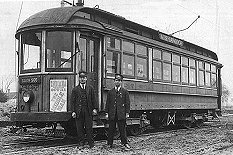
|
_________________________________________________
|
|
|
RetroLisa
| ___________________________________________________________________ | __ | _____________________________ | _______ | Ocean Travel
In the 1910s, the average steamer could cross the Atlantic Ocean in seven days. Ships designed for speed could make the crossing in as little as four days. The ships of the Cunard and White Star Lines were the most splendid ocean-going vessels of the day. The Cunard Line owned the Lusitania (1907), Mauretania (1907), and Aquitania (1914), and the White Star Line owned the Olympic (1911) and Titanic (1912). The passenger and crew capacity of these liners ranged from 2,100 to 3,500 people. There were three classes of passengers: first class, second class, and steerage.
Smaller liners in operation during the 1910s included the White Star Line's Teutonic, Majestic, Baltic, and Celtic, Hamburg-America's Bismarck and Imperator, and the ships of the American and Red Star Lines.
Many large ocean liners were designed to be converted into military vessels on short notice. During World War I, several of these ships were taken out of regular service and used as hospital and troop ships.
For first class passengers, ocean liners were truly floating palaces. The Olympic featured opulent dining rooms, gymnasiums, reading rooms, turkish baths, grand staircases, elevators, and even an indoor swimming pool. The guest rooms had fireplaces, fine mahogany woodwork, private bathrooms, and servants quarters.
Below deck, the accommodations for steerage passengers were not so grand, although they were much better than what had been available in the past. The sleeping cabins were simple, containing just bunks and a washbasin. Wooden benches and family-style dining took the place of fancy dining rooms and lounges.
RMS Lusitania
RMS Titanic
RMS Olympic
| |
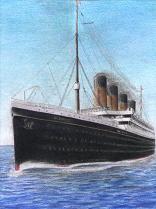
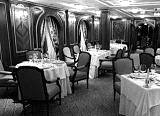
|
_________________________________________________
|
|
|
RetroLisa
| ________________________________________________ | ___ | ______________________________________________ | ________ | Air Travel
In the 1910s, most people were convinced that the future of passenger flight lay with airships. Airplanes were rickety and dangerous, while airships were slow and steady. Airplanes might be fine for thrill rides and mail transport, but certainly not for passengers!
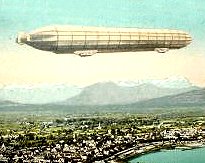
airships
Airships were also known as dirigibles. They fell into two categories....rigid airships that were built over an aluminum frame, and blimps that used internal gas pressure to retain their shape. Both types were self-powered and steerable.
blimps
Early blimps were simply passenger balloons fitted with propellers for steering. They adopted their characteristic elongated shape in the late 1800s and added steam and gas motors for increased speed. The U.S. Army purchased a blimp in 1908, and Italy used blimps for military reconnaissance missions in 1911 and 1912.
rigid airships
In Germany, Count Ferdinand Von Zeppelin patented his rigid airship design in 1895 and built his first ship in 1900. By 1909, his company had completed five rigid airships. These hydrogen-filled wonders captured the public's fancy and were soon being referred to as zeppelins.
the first airline
In Germany, commercial passenger service began in 1909 when DELAG ("Deutsche Luftschiffahrts-Aktion Gesselschaft") was formed. This was the world's first commercial airline. Between 1909 and 1914, DELAG's fleet of seven rigid airships transported 35,000 passengers on 1,500 flights throughout Germany.
rigid airships in war
The German military purchased 15 rigid airships between 1908 and 1914. After World War I broke out in 1914, Germany's passenger service was halted and the civilian airships were used for wartime bombing missions. England also had a handful of rigid airships in operation during the war, having begun an airship program in 1909.
When the war ended, two new German zeppelins were built and passenger service resumed. In 1921, Germany was forced to surrender her zeppelins, due to a stipulation in the 1919 Treaty Of Versailles.
| |
aeroplanes
The first successful airplane flight took place in 1903. At first, no one could see any practical use for heavier-than-air flight. The U.S. military didn't witness a demonstration or purchase a plane until 1908.
The situation gradually began to change in the 1910s. It started in 1909 when the first airplane dealership was formed and the first plane was purchased by a non-military group. In England, sacks of mail were occasionally transported by plane beginning in 1910. The practice spread to America in 1911. Regularly-scheduled airmail flights began in 1918.
airplanes in war
France, Italy, and the United States began using airplanes for military reconnaissance missions in 1910. The first aerial bombing from an airplane took place during the Turko-Italian War in 1911. Airplane technology made great strides during World War I, and this paved the way for commercial aviation on a large scale when the war was over.
an airplane passenger service!
In 1913, the unthinkable became reality....an airplane passenger service was established between San Francisco and Oakland in California. The following year, a second passenger service began operating between St. Petersburg and Tampa in Florida. In 1919, new airplane passenger services were established between London and Paris, between Florida and Havana, and in Germany.
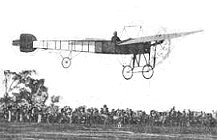
transatlantic flight
In 1919, a decade of innovation culminated in the first transatlantic flights:
• Airplane: Captain Alcock and Lt. Brown, Newfoundland to Ireland, 16 hours and 12 minutes
• Rigid airship: British dirigible R-34, Scotland to Long Island, 108 hours |
_________________________________________________
|
|
|
RetroLisa
| ______________________________________________________________ | __ | __________________________________ | _______ | On The Road
Travel by auto was truly an adventure! Automobiles had been around for only 20 years, and our roads were still not ready for them.
dirt roads
Streets were paved in the cities and some of the smaller towns. In the country, however, most of the roads were still dirt. Muddy in the spring, dusty and rutted in the summer....what fun!
Motorists who found themselves stuck in the mud were subjected to many indignities. If a wagonload of smart-aleks passed by, they invariably called out, "Get a horse!" It was quite embarrassing when circumstances forced a driver to depend on the kindness of a local farmer to hitch up his team and pull the car out.
improved roads
The key feature of an improved road was proper drainage. This was accomplished by raising the road, grading it, and digging ditches on the side. Grading the road made it higher in the middle, and ditches provided a place for runoff water to collect. In some areas, a surface of gravel or macadam (crushed stones) was added. Oil was often applied to keep the dust down.
Road conditions varied from state to state. In 1913, it was estimated that only 10 percent of Illinois roads were improved in a permanent manner, and of these, 20 percent were surfaced with macadam and 80 percent with gravel. Massachusetts, on the other hand, had improved 50 percent of their roads in 1913.
Motorists praised the delights of driving on improved roads, and auto clubs were always urging farmers and local governments to build more of them.
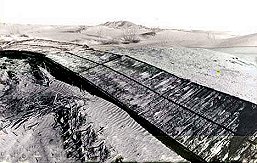
plank roads
In the desert, some highways were reduced to nothing more than wooden plank roads. The most famous of these was the Plank Road in southern California. Built in 1915 as part of the Dixie Overland Highway, it was seven miles long and provided a thrilling experience for motorists driving over the Imperial Sand Dunes.
concrete roads
Concrete roads were also known as hard roads. In 1891, Ohio was the site of America's first concrete road. By 1910, there were also short stretches of concrete highway in New Jersey, Michigan, and Long Island. A 24-mile stretch of concrete highway was built in Arkansas in 1913.
Construction of the privately-owned Long Island Motor Parkway began in 1907. The owners of this 48-mile concrete road originally hoped to use it for auto racing, auto testing, and toll traffic. By the time it was finished in 1911, New York had outlawed highway racing and motorists were finding the $2 toll to be a bit steep. In 1917, the toll was lowered to $1 in an attempt to encourage drivers to use the road.
By 1914, there were 2,348 miles of concrete highway in the United States.
national auto trails
The Lincoln Highway was the first cross-country highway designed especially for auto travel. The route was assembled from existing highways in 1913 and improved with gravel before paving began in 1914. In strategic locations, short stretches of highway were paved in concrete to encourage local businesses to pitch in and help fund the remainder. These seedling miles were placed between muddy patches to demonstrate the benefits of concrete paving. The process moved very slowly, and much of the road remained unpaved in 1920.
The construction of the Lincoln Highway inspired road boosters to create more official automobile highways. These roads were identified by name, as the federal highway numbering system didn't exist yet. Popular national auto trails in the 1910s included the Dixie Highway, National Old Trails Road, Midland Trail, West Michigan Pike, Red Ball Route, Jefferson Highway, William Penn Highway, and Pontiac Trail.
| |
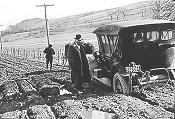
"Get a horse!"
Stuck In The Mud
A 1910 Road Trip
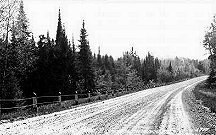
Improved road
Plank Road In California
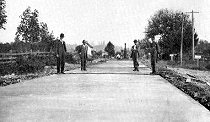
Concrete road
Lincoln Highway Association
About The Lincoln Highway
Long Island Motor Parkway
Lincoln Highway Museum & Archives
|
| ________________________________________________ | ___ | ______________________________________________ | ________ | the Good Roads movement
In 1893, the federal government formed the Office Of Road Inquiry to study the best methods of road building. For the first decade or so, very few changes were made. Cars were still quite rare and farmers didn't want to pay higher taxes for roads they probably wouldn't use.
something needs to be done
In the 1910s, it became apparent that the road situation couldn't be postponed any longer. Our way of life was becoming dependent on motorized travel, and the highway system was in horrible shape. Dirt roads that were built for buggies and bicycles were crumbling under the weight of trucks. The few highways in existence couldn't accommodate the two million cars being built each year. Even farmers, who were now using trucks, realized that paved roads would help them transport their produce to markets.
During the 1900s and 1910s, various Good Roads movements were launched in almost every state. During the 1910s, hardly a week went by that didn't include a newspaper editorial about the condition of our roads and what should be done to improve them.
1916 Federal Highway Project
Federal Highway Administration
"Public Roads" Magazine, 1918
| | state funding
The biggest obstacle to building new roads was deciding who should pay for them. In the old days, roads were funded by local towns, townships, and counties. This arrangement was acceptable when most rural roads were used exclusively by local farmers. In the 1910s, officials realized that highway travel was no longer strictly local, and therefore should be funded by the state and federal government. With this in mind, many states adopted their own highway acts at this time. These acts guaranteed that state-aid roads and state bond issue highways would receive a percentage of their funding from auto registration fees and fuel taxes.
federal funding
On the national level, the Office Of Road Inquiry went through several name changes before becoming the Bureau Of Public Roads in 1918. A major step forward was taken in 1916 when the Federal Highway Act was launched. The goal of this act was to establish a cross-country network of quality roads that would be partially funded by the federal government. The act got off to a slow start, thanks to wartime shortages and funding debates. Only a handful of federal-aid highway projects were completed by 1920.
|
_________________________________________________
|
|
|
RetroLisa
| _________________________________________________________________ | __ | _______________________________ | _______ | Automobile Travel
road signs
There were very few road signs or markers in the 1910s. Sometimes the local auto or bicycle club erected signs, but they were not standardized or consistent. In some areas, major routes were indicated by concrete markers or colored bands on telephone poles. In other areas, they were marked by nothing more than a dab of paint on a tree or fence. Most rural roads didn't have formal names and weren't marked at all.
B.F. Goodrich Guideposts
Between 1910 and 1917, the B.F. Goodrich Company of Ohio erected a network of B.F. Goodrich Guideposts. These tall round signs gave the mileage to nearby towns and were placed on major roads at three-mile intervals. They also advertised Goodrich tires and were accompanied by the "Goodrich Route Book". By 1917, there were 10,000 Guideposts throughout the country. The program was discontinued during World War I.
road maps
The first long-distance road maps and route books were published in the 1900s to assist drivers in cross-country auto races. By the 1910s, there were many guides available using a variety of formats:
• Route cards given out by the local auto club
• Strip maps showing a single route
• Network maps showing all available highways in a given region
• Running directions: booklets that outlined specific routes through the use of photographs, descriptive paragraphs, and odometer distances between landmarks.
A map is only as good as the labeling system it depicts. The use of running directions may seem inefficient and confusing to us today, but it was the best method available at the time to guide motorists through a maze of unmarked dirt roads.
The situation began to improve in the late 1910s, when many unmarked roads became part of a national trail or state highway system. These roads received an identifying name or number and rudimentary signage, resulting in a network of highways that were relatively easy to follow both on the ground and on a map. Rand McNally invented their own highway numbering system in 1918 and erected signs to correspond to their maps.
These factors ultimately made network maps the better choice for auto travel. To promote the idea of a national highway system, the first nationwide network maps were published in the 1910s.
In 1913, the Gulf Oil Company was the first service center chain to give away free road maps. This practice spread to the other oil companies in the 1920s.
| |
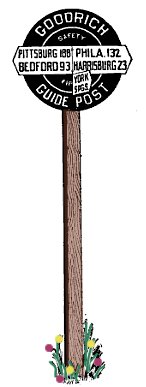
Road Maps Of Pennsylvania
Evolution Of Michigan Road Maps
1915 Automobile Blue Book
|
_________________________________________________
|
|
|
RetroLisa
| _________________________________________________________________ | __ | _______________________________ | _______ | Refueling
bucket & funnel
Before filling stations were introduced, gasoline was sold by oil companies, hardware stores, and garages as a sideline. It was stored on the premises in a large barrel and was dispensed by the merchant into five-gallon cans. The motorist poured the gas into the tank with a funnel and measured the level with a wooden dipstick.
gas pumps & storage tanks
The first gas pumps were introduced in the 1890s. Early pumps were designed for indoor garage use and were connected to indoor tanks and barrels. The first underground tanks were introduced in 1902.
In 1905, the invention of the curb cabinet made outdoor refueling possible. These tall wooden structures contained storage tanks, pumps, and flexible hoses that could be connected directly to the car. They were nicknamed filling stations and were placed at the curb for easy access. The enclosures were airtight and could be locked when the pump was unattended.
Curb cabinets underwent a transition in the late 1900s. The wooden housings were replaced with smaller metal housings, the enclosed tanks were removed, and the pumps were connected to underground tanks. This was the birth of the modern gas pump.
These new outdoor pumps were usually installed at the curb, where they occasionally caused traffic jams. Sometimes a motorist crashed his Model T into a curbside pump, causing an explosion or fire.
blind pumps
The gas was not visible inside these early pumps, and unscrupulous vendors found various ways to cheat their customers. They sold watered-down gas and rigged the self-measuring devices to give false readings. Motorists became very distrustful of these blind pumps.
visible pumps
To ease the concerns of the motoring public, a new type of pump was introduced in the mid 1910s. Known as a visible pump, this device added an extra step to the refueling process. Gas was pumped from the underground tank into a glass vessel perched on top of the pump, where it remained until being drawn through the hose by the attendant. A bell sounded at one-gallon intervals. Through the glass the customer could see the quality and quantity of gas for himself.
Visible pumps were not perfect. The operator could still cheat the customer by putting a brick inside the vessel to alter the liquid level, or he could misalign the gallon markers. In the summer, the sun heated the inside of the vessel, causing the gas to expand and flow back into the underground tank. To get the most gas for their money, motorists refueled early in the morning or in the cool of the evening.
globes
In 1912, the first lighted glass globes were placed on top of the pumps. Originally, they were simply for decoration and were printed with labels such as FILTERED GASOLENE or VISIBLE GASOLINE. In the late 1910s, the oil companies began to put their logos on the globes.
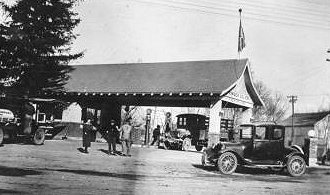
drive-in stations
In the 1900s, the first off-road refueling stations solved the problem of curbside congestion. In 1905, the Automobile Gasoline Company launched a chain of 40 drive-in stations in the St. Louis area. Standard Oil entered the market in 1907 with a drive-in station in Seattle, followed by a chain of 34 identical stations in 1914. Gulf Oil opened a station in Pittsburgh in 1913.
The Gulf Oil station gave many people their first glimpse of modern filling station design. Rather than place the gas pumps at the curb, the pumps and a small shed for the attendant were set back from the street on a corner lot. The station also provided service, accessory sales, restrooms, and free road maps.
In the 1910s, curbside pumping was generally the norm in the cities, where space was at a premium. Drive-in stations were more prevalent in the country and on the outskirts of town.
| |

Curbside pump with decorative glass globe
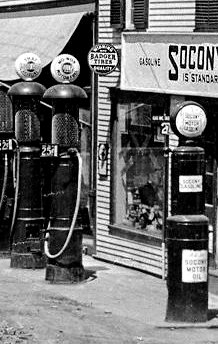
Two visible pumps and a traditional pump at a curbside station
Gas Station History
The First Gulf Oil Station
The Long Oil Company Of Kansas
Beman Curb Filling Stations
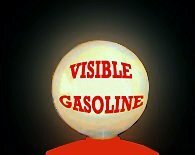
|
_________________________________________________
|
|
|
